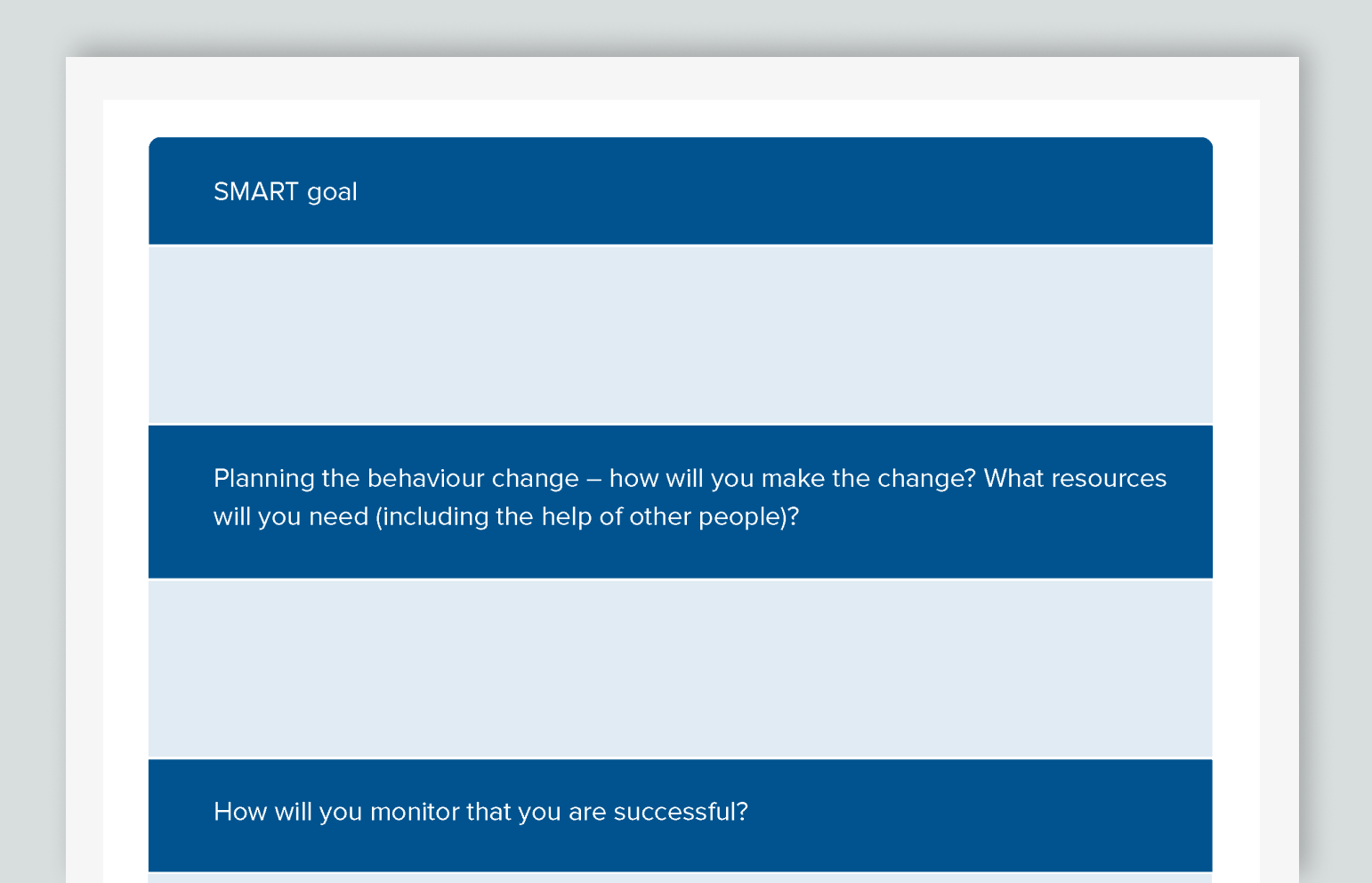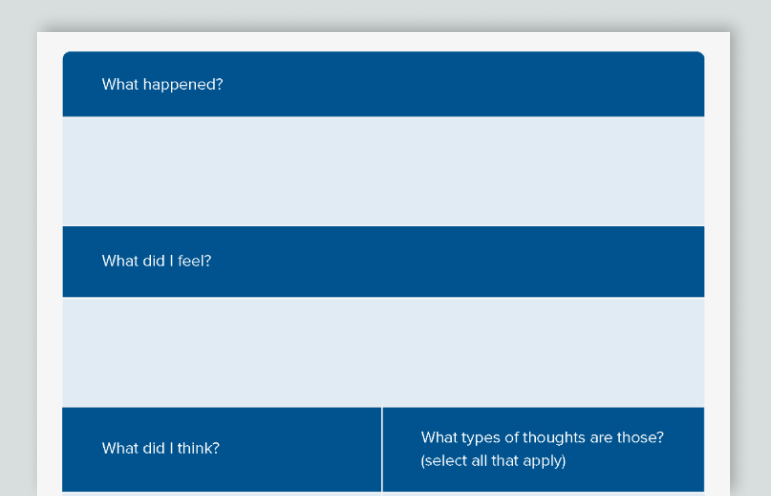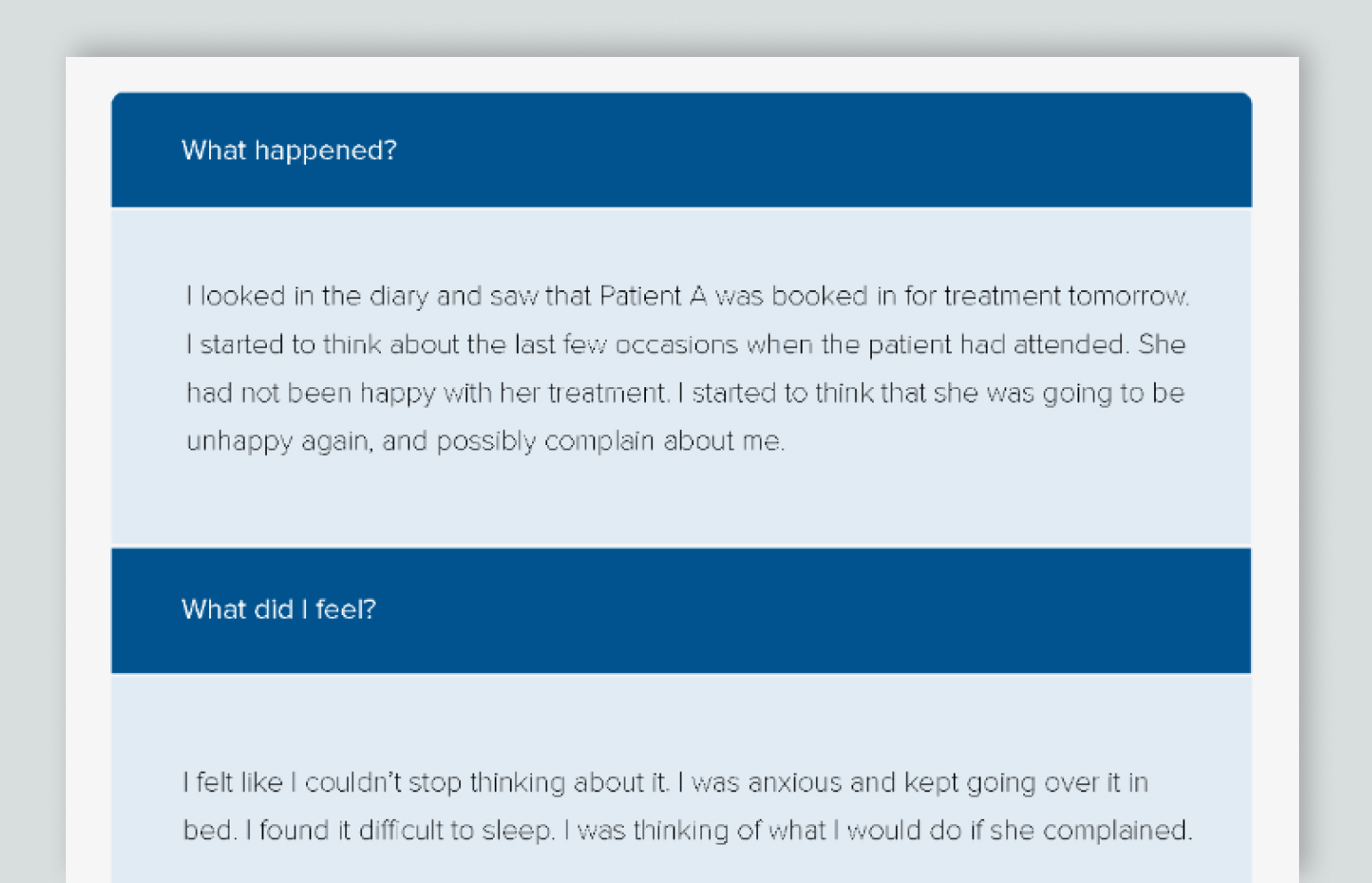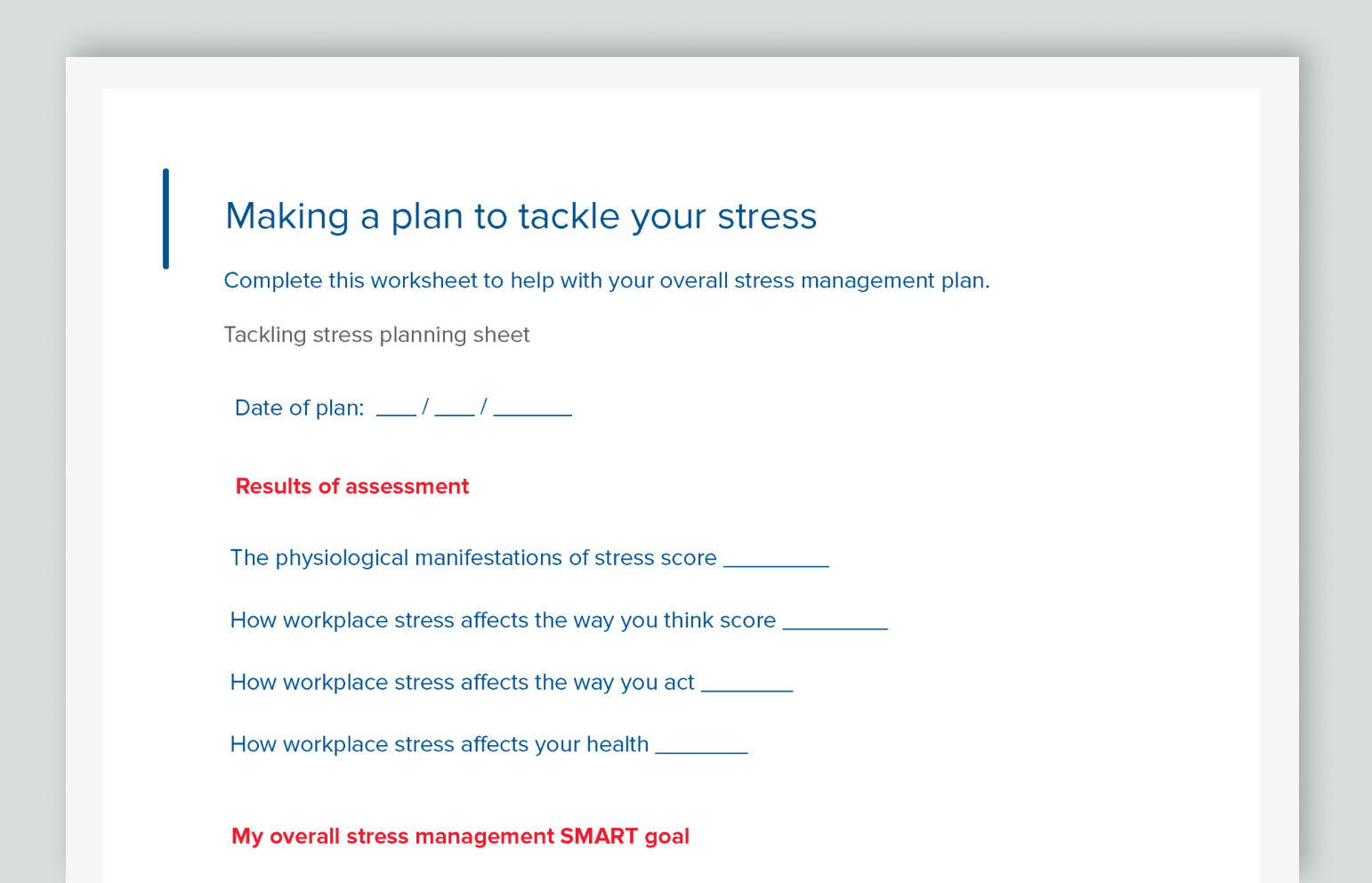Below you will find recommendations to take action on your mental health and improve your well-being.
Individual level
Do
Do: Implement prevention and proactive strategies
02 Step two
In this section we will explore specific techniques that you can adopt to address the effect that your workplace stress is having on you. This is broken down into sections dealing with the way in which stress is affecting your physiology:
- The strains that working in a dental environment has on your body
- Your behaviour and your thoughts
Note: This is not designed to be read in a linear fashion, rather you can pick out particular sections which you think are most relevant to you, especially based on your responses in the DETERMINE section.
Coping with the physiological manifestations of stress
Find below three actions you can try today.
01 Relaxation techniques
Increased muscle tension and changes in breathing (shallow breathing or holding the breath) are part of the physiological response to stress. Simple relaxation techniques can help with this.
We can identify two approaches:
Tip: Try to use them between patients or other breaks.
- Quick relaxation techniques
- Breathe in deeply and breathe out slowly once between patients. Try the technique of breathing in deeply for a slow count of three, hold the breath for the same count and exhale slowly for a count of three. Concentrate on emptying and filling the lungs. As you breathe out imagine releasing the tension in your shoulders and neck. Breathing like this once or twice should bring some short term relief from tension.
- Close your eyes and count to three.
- Take a lunch break, go for a walk.
Tip: Try meditation and relaxation mobile apps.
- More intensive relaxation techniques
Progressive muscular relaxation
- Progressive muscular relaxation is the most widespread technique employed as a relaxation exercise. It involves tensing and then r elaxing muscle groups in turn.
- The idea being that we learn to distinguish between a state of tension and a state of relaxation. The principles of progressive muscular relaxation are easily learnt, but may take some time to perfect.
Note: These relaxation exercises take longer to perform and so are not for use in the dental clinic but at home for those who are experiencing high levels of muscular tension.
Instructions for progressive muscular relaxation are given in this table.
- Find a quiet place to relax. The room should be warm and comfortable. When you are first learning to relax, it is usually easiest to start when you are lying down, so a bedroom may be a good place. Set aside about half an hour for your relaxation. Your clothes should be loose: avoid anything that is tight at the neck or the waist. Take off your shoes.
- Lie down on your back with your arms at your side and your legs out straight. Close your eyes. Concentrate on your breathing. Keep your breathing regular, deep and slow. Breathe in slowly to a count of three, then breathe out slowly to a count of three. Next concentrate on your toes. Scrunch them up so that they are tense and hold for a count of three, then relax them. Notice the difference between the feeling of your toes when they are relaxed and the feeling when they are tense.
- Repeat the tensing of the toes, hold the tension, and relax. Next tense your ankles and calves, hold the tension for a count of three and then relax.
- Again, notice the difference between tension and relaxation.
- Continue this process of tensing and relaxing muscle groups throughout your body moving upwards towards your head. In order, tense and relax
- Your thighs
- Your buttocks
- Your stomach muscles
- Your shoulders
- Your upper arms
- Your lower arms and hands
- Your neck muscles
- Your facial muscles
At each stage, it is important to learn to notice the difference between the feeling of tension and the feeling of relaxation.
When you have completed the process of successively tensing and relaxing each muscle group, lie for a moment feeling the sensation of relaxation throughout your whole body. Stand up slowly and take a few moments to ease yourself into your usual routine.
Note: With time you will come to be able to induce a state of relaxation in your muscle groups without going through the procedure of tensing the muscles. You may start to notice during the day that you are becoming tense and can just ease the muscle tension where you are sitting or standing.
See some examples in the additional resources.
02 Mindfulness based relaxation
Mindfulness based techniques for stress reduction and relaxation have become increasingly popular and there is a good evidence base for their effectiveness.
Mindfulness asks you to notice sensations without trying to change them, accepting that these sensations are part of your experience at this moment in time. The goal is to increase awareness of the sensations you are experiencing and avoid the additional struggle of seeking to change them.
Note: Mindfulness is a skill which requires practice to perfect, but is well worth trying. You will find that the more you do it, the greater the benefits. There are many guides to Mindfulness, this website provides a useful introduction:
https://www.nhs.uk/mental-health/self-help/tips-and-support/mindfulness/
03 Exercise
Aerobic fitness improves the ability to cope with stress, by reducing the tension in muscles, giving a physical outlet for the energy mobilization, which is part of the stress response and improving your aerobic capacity.
For guidance on exercise and wellbeing see:
Tip: You can exercise vigorously for 75 minutes a week, or moderately for 150 minutes. For moderate exercise, walking is a really good option – a 30 minute walk over your lunchtime every day or a 15 minute walk at the start and end of your day would mean you reach your total.
Note: If it has been a long time since you have exercised, you may want to consider speaking to your General Medical Practitioner or Physician before you start.
Reducing stress in your work environment
The physical strain of dentistry is an important consideration in the health and well-being of the dental team. FDI has created resources to support the well-being of staff, including an exploration of the importance of maintaining correct posture and ergonomic design in the surgery. For these resources see:
https://fdiworlddental.org/ergonomics-and-posture-guidelines-oral-health-professionals
Here are a few simple steps that you can consider to help with the strain placed on your body by working in dental practice:
01 Reducing strain on eyes
- Ensure that levels of lighting during surgery are good, particularly in the working area.
- Wear protective eye wear when operating.
- Take an ‘eye rest’ at intervals. Every half hour or so, shift your focus to a far away object, for example, looking out of a window. Ten seconds is long enough.
- Have your eyes checked regularly.
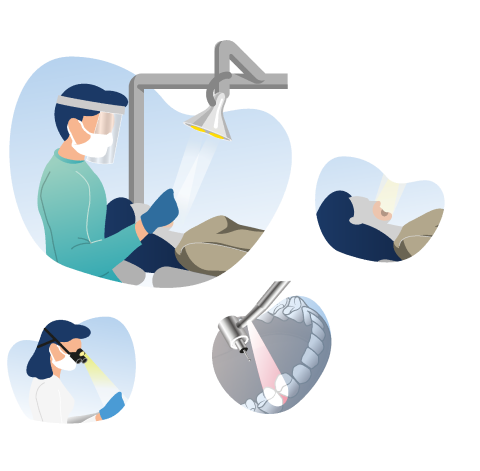
02 Reducing strain on the ears
- Take breaks from high frequency noise, such as ultrasonic scalers and the high speed drill. Take care of your hearing more generally, avoiding high levels of noise exposure outside the dental clinic.
- Try wearing noise protectors against ultrasound.
03 Reducing strain on the muscles and skeleton
- Ensure that your dental chair and seats are ergonomically correct and at the right height for you and your colleagues.
- Ensure that all equipment that you routinely use is within easy reach.
- Take regular breaks to stretch your muscles (neck, back and calf).
- Avoid adopting uncomfortable sitting positions which give direct vision.
- Take regular exercise
- Get back pain treated as soon as possible
Check FDI’s video on Ergonomics and Posture.
Changing your behaviour
In this section we outline a technique for analyzing your behaviour in response to stress. You may wish to refer back to the questionnaire that you completed to identify one or more of the behaviours that you wish to address, or there may be another behaviour you wish to change. If you have not completed the questionnaire, go to Individual level: DETERMINE.
01 Analyzing your behaviour
The principle behind the behaviour change approach follows three steps:
- SMART goals refer to targets that are:
Specific
Measurable
Achievable
Relevant
Time-Bound
A Specific goal is one that outlines how you will achieve the goal, and should be defined in terms of behaviour. So for example, it might be “Walk for 30 minutes a day for five days a week”. This is also Measurable. A goal of “Walking more” would not be specific or measurable. The goal should be Relevant to you and your situation, and Achievable for you. It is important to set realistic goals that stretch you but are not so unobtainable that they are demotivating. Progressive goals can be used to work towards a bigger goal – for example, the walking goal could start at 2 days per week and gradually over time work up to 5 days, or alternatively could be five days a week but gradually increase the time spent walking. The Time-bound target can refer to how long an activity takes, or how long before the goal is reviewed.
- Planning the behaviour change
Having set a goal, research suggests that the success of achieving the goal is increased if you spend time thinking about when, where and how you will undertake the behaviour and the resources you will need – this is called Implementation Intentions, which refers to planning how you will implement the change.
- One way to do this is to mentally form an image of you engaging in the behaviour. For example, if you wish to reduce your alcohol intake, you could set a goal such as “To drink no more than 3 to 4 units per day, and have at least 3 days of no alcohol intake each week”.
- When planning for this, you might want to start by thinking what days would be easiest for you to go alcohol free – this might include exploring the situations in which you usually drink alcohol – is it with your evening meal? In which case you could consider substituting alcoholic drinks for other options, including alcohol free versions. Making an explicit plan will help to pre-empt situations where the behaviour has previously been triggered.
- Monitoring the change
Finally, monitoring the behaviour will help to show your success, and where you are less successful can help to identify what the challenges to changing your behaviour are.
There are several ways to monitor your progress: Making a note in your diary (online or paper), designing a special record sheet, and there are even applications that will help support behaviour change, for instance the WOOP app: https://woopmylife.org/en/home or the STRAVA app for exercise. Most smart mobile phones will record your daily steps.
Frequent problems with behaviour change
- The goal is unrealistic. The goal may be too great a change to be achievable. Try breaking it down into smaller steps, which can then be accumulated into a bigger change.
- The situation that the person is in does not allow the planned change(s). For instance, while you may plan to exercise during lunchtime, however work emergencies and catching up with routine work inevitably means you never manage to take a lunch break. In this case the plan needs to change.
- The initial change is positive but after a certain amount of time, the behaviour slips back. Relapse is a normal part of the behaviour change process, and requires a return to the planning stage. How will you plan to ensure that you maintain the change?
Here is a sheet to help you plan your behaviour change.
Behaviour change planning sheet
02 The five Ds of managing workload
Often we find that there are tasks that take up a lot of time, or which we find difficult and challenging. These can be a source of additional stress and may be diverting your energies from other tasks. One way to approach this is to explore the 5 ‘D’s.
Delegate
Could this task be done as well or better by someone else? Why do you need to do it?
Divide
Break the task into smaller bits which can be delegated or shared
Divert
Is there a different way to tackle the problem? If you recall the team member who was being asked to deal with equipment breakdown, is there a way to avoid emergencies by planning a regular maintenance schedule for all equipment?
Discuss
Discuss and share your difficulties with colleagues. They may have experience of approaching issues in different ways, or experiences which could help reduce some of the problems you are facing
Develop
Learn new skills. These might include skills of business management, and stress management
Changing your thoughts
This section will outline a technique to explore the unhelpful thoughts that may be a consequence of the stress you are experiencing, and which may affect your mental health and well-being. This approach is based on the techniques of Cognitive Behavioural Therapy.
- It starts by examining your thoughts – these are often automatic and unquestioned.
- We will explore whether there are alternative ways of thinking about the situation that might be more helpful.
Note: the goal is not to think positively – this is unreasonable since some situations are inherently negative. The question is whether the thoughts you are having in relation to the situation are helpful in addressing the problem, or unhelpful.”
01 Identifying and questioning irrational/unhelpful thoughts
The worksheet below is designed to help you through this process:
- It starts by asking about the situation that you found yourself in, how it made you feel and importantly any particular thoughts that were at the forefront of your mind.
- Then explore whether the thoughts you were having fall into any of the unhelpful patterns identified in the section “How workplace stress affects the way you think”.
- Common examples include ‘Black and White thinking’ – things are either right or wrong, whereas it may be possible that the situation is more complex – in a conflict between two people, both sides may have merit but are possibly talking from different perspectives and emphasizing their viewpoint to the exclusion of the other. Acknowledging the common ground can be helpful. Similarly, identifying where you are putting yourself under pressure by thinking that you ‘should’ be doing something is very common, particularly amongst dental professionals, many of whom are perfectionists. Identifying that rather than ‘should’, you would ‘like to’ do something, gives more flexibility – it may be that you can achieve more by delegating, or seeking support.
- The final challenge is to replace the unhelpful thoughts with the helpful ones when you find yourself in stressful situations. This can be very difficult at first but with practice it will become easier.
Addressing unhelpful thoughts sheet
How to complete the unhelpful thoughts sheet
As an example, let’s take the quote below from a dentist who was concerned about a patient who they believed would complain about their treatment:
“I used to look in the appointment book each night before I left … and if I saw this one name, Patient A, I’ll call her, that’s it I’d be up all night worrying if she would be happy with her treatment or complain”
Here’s an example of a completed thoughts sheet:
Making a plan to tackle your stress
Having completed your individual stress assessment, what steps do you think would be useful for you to take? Remember that it is probably best to make small changes initially that will accumulate over time.
01 Examples of actions could include:
- Making an appointment to discuss your stress with your General Medical Practitioner or Physician
- Making a plan to engage in regular aerobic exercise
- Try some relaxation techniques every day
It will help if you make a plan for this change as outlined in the section “Changing your behaviour”. You may want to read that before making a plan for your overall stress management.
Complete the worksheet below to help with your overall stress management plan.
Note: the sheet includes setting a date to reassess yourself using the scales in the ‘DETERMINE’ section. Try to get in the habit of regularly auditing your stress levels and setting a plan to address them, or maintain them if you find you are in the right place.
Tackling stress planning sheet

